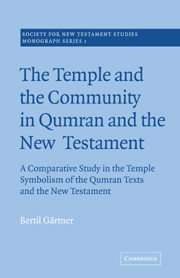 The Temple and the Community in Qumran and the New Testament
The Temple and the Community in Qumran and the New Testament Book contents
- Frontmatter
- Contents
- List of Abbreviations
- Introduction
- AUTHOR'S NOTE
- I The Priesthood and the Jerusalem Temple
- II The Temple Priests and Qumran
- III The ‘New Temple’ in Qumran
- IV Temple Symbolism in the New Testament
- V Temple Symbolism and Christology, Collective and Individual
- Bibliography
- Index of Authors
- Index of Subjects
- Index of Passages Quoted
I - The Priesthood and the Jerusalem Temple
Published online by Cambridge University Press: 26 February 2010
- Frontmatter
- Contents
- List of Abbreviations
- Introduction
- AUTHOR'S NOTE
- I The Priesthood and the Jerusalem Temple
- II The Temple Priests and Qumran
- III The ‘New Temple’ in Qumran
- IV Temple Symbolism in the New Testament
- V Temple Symbolism and Christology, Collective and Individual
- Bibliography
- Index of Authors
- Index of Subjects
- Index of Passages Quoted
Summary
JUDAISM was rich in groups and factions. There were the groups which gathered around judges, prophets and popular leaders of various kinds; there were groups connected with the organization of the army; and many more: all were interrelated and played an important role in the social and religious life of the people. The most important of these groups during the periods when the Jerusalem temple provided a national focus were the Levites and priests. Another group which took over the spiritual leadership of the nation during the last period of the temple was the company of the scribes. But although the scribes became spiritual leaders and were responsible for the education of the people, the priests retained their position of prominence, for reasons connected with their necessary offices in the temple. It was characteristic of the priests that they formed a closed group, membership of which was determined by heredity: they were proud to be of the family of Aaron. Priests were born, not made. Priestly marriage was also hedged about by a multitude of restrictions, for the same reason, the preservation of priestly exclusiveness.
The priests thus formed a holy company distinct from the common people. Their task was to preserve the holiness and purity of Israel, and their holiness was directly derived from that which flowed forth from the temple. The temple was a focus of holiness, an idea which was stressed frequently in the days of the last temple. Yahweh himself dwelt there: there were his kabod and sem; hence Jerusalem could be called the holy city and Israel the holy people.
- Type
- Chapter
- Information
- The Temple and the Community in Qumran and the New TestamentA Comparative Study in the Temple Symbolism of the Qumran Texts and the New Testament, pp. 1 - 3Publisher: Cambridge University PressPrint publication year: 1965


